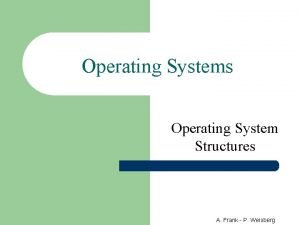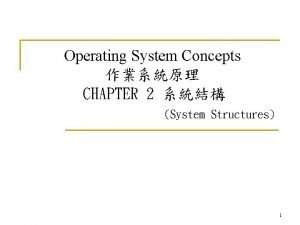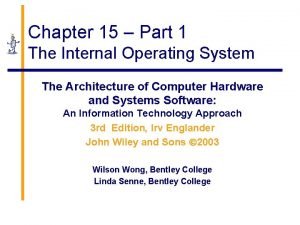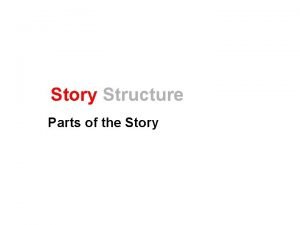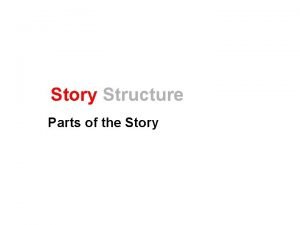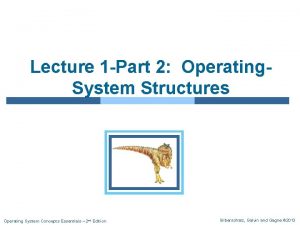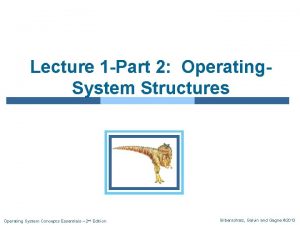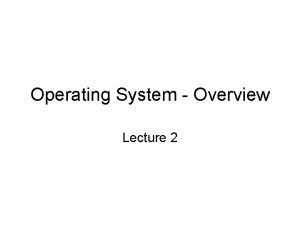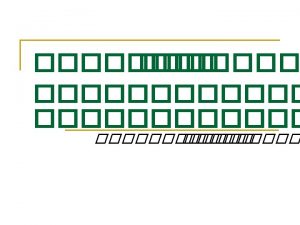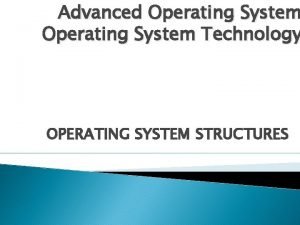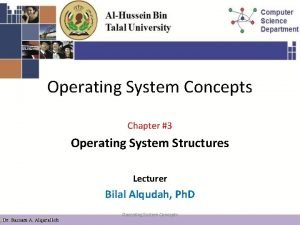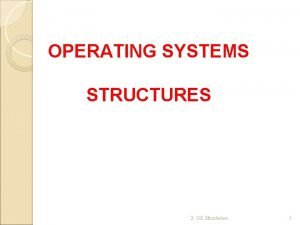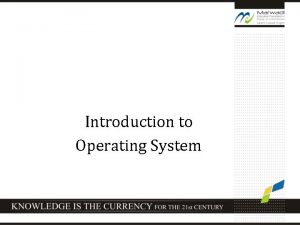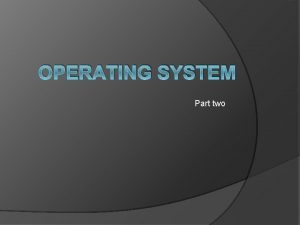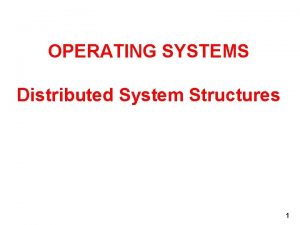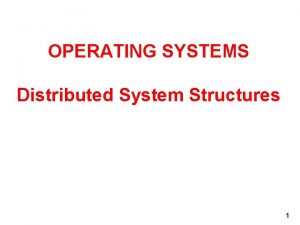Lecture 1 Part 2 Operating System Structures Operating















- Slides: 15

Lecture 1 -Part 2: Operating. System Structures Operating System Concepts Essentials – 2 nd Edition Silberschatz, Galvin and Gagne © 2013

Operating System Services n Operating systems provide an environment for execution of programs and services to programs and users n One set of operating-system services provides functions that are helpful to the user: l User interface - Almost all operating systems have a user interface (UI). l Program execution - The system must be able to load a program into memory and to run that program, end execution, either normally or abnormally (indicating error) l I/O operations - A running program may require I/O, which may involve a file or an I/O device Operating System Concepts Essentials – 2 nd Edition 2. 2 Silberschatz, Galvin and Gagne © 2013

Operating System Services (Cont. ) n One set of operating-system services provides functions that are helpful to the user (Cont. ): l File-system manipulation - The file system is of particular interest. Programs need to read and write files and directories, create and delete them, search them, list file Information, permission management. l Communications – Processes may exchange information, on the same computer or between computers over a network l Error detection – OS needs to be constantly aware of possible errors 4 May occur in the CPU and memory hardware, in I/O devices, in user program 4 For each type of error, OS should take the appropriate action to ensure correct and consistent computing Operating System Concepts Essentials – 2 nd Edition 2. 3 Silberschatz, Galvin and Gagne © 2013

Operating System Services (Cont. ) n Another set of OS functions exists for ensuring the efficient operation of the system itself via resource sharing l Resource allocation - When multiple users or multiple jobs running concurrently, resources must be allocated to each of them 4 Many types of resources - CPU cycles, main memory, file storage, I/O devices. Accounting - To keep track of which users use how much and what kinds of computer resources l Protection and security - The owners of information stored in a multiuser or networked computer system may want to control use of that information 4 Protection involves ensuring that all access to system resources is controlled 4 Security of the system from outsiders requires user authentication, extends to defending external I/O devices from invalid access attempts l Operating System Concepts Essentials – 2 nd Edition 2. 4 Silberschatz, Galvin and Gagne © 2013

A View of Operating System Services Operating System Concepts Essentials – 2 nd Edition 2. 5 Silberschatz, Galvin and Gagne © 2013

User Operating System Interface - GUI n User-friendly desktop interface l Usually mouse, keyboard, and monitor l Icons represent files, programs, actions, etc l Various mouse buttons over objects in the interface cause various actions (provide information, options, execute function, open directory (known as a folder) n Many systems now include both CLI and GUI interfaces l Microsoft Windows is GUI with CLI “command” shell l Apple Mac OS X is GUI interface l Unix and Linux have CLI with optional GUI interfaces Operating System Concepts Essentials – 2 nd Edition 2. 6 Silberschatz, Galvin and Gagne © 2013

Touchscreen Interfaces n Touchscreen devices require new interfaces l l Mouse not possible or not desired l Virtual keyboard for text entry Voice commands. Operating System Concepts Essentials – 2 nd Edition 2. 7 Silberschatz, Galvin and Gagne © 2013

User goals and System goals l User goals – operating system should be convenient to use, easy to learn, reliable, safe, and fast l System goals – operating system should be easy to design, implement, and maintain, as well as flexible, reliable, error-free, and efficient Operating System Concepts Essentials – 2 nd Edition 2. 8 Silberschatz, Galvin and Gagne © 2013

The Classification of Operating systems n Multi-user: Allows two or more users to run programs at the same time. Some operating systems permit hundreds or even thousands of concurrent users. n Multiprocessing: Supports running a program on more than one CPU. n Multitasking : Allows more than one program to run concurrently. n Multithreading : Allows different parts of a single program to run concurrently. n Real time: Responds to input instantly. Operating System Concepts Essentials – 2 nd Edition 2. 9 Silberschatz, Galvin and Gagne © 2013

Layered Approach n The operating system is divided into a number of layers (levels), each built on top of lower layers. The bottom layer (layer 0), is the hardware; the highest (layer N) is the user interface. n With modularity, layers are selected such that each uses functions (operations) and services of only lower-level layers Operating System Concepts Essentials – 2 nd Edition 2. 10 Silberschatz, Galvin and Gagne © 2013

Simple Structure -- MS-DOS n DOS (Disk Operating System) gained a reputation by supporting operating systems developed by IBM and Windows. n DOS was prominent in the industry up until support was terminated for Windows ME. n Though it's not as sophisticated as modern systems, DOS offers many advantages to the user. l This system is very stable and rarely endures crashes. n While the system is still used, DOS has become more difficult to manage as support is limited. Operating System Concepts Essentials – 2 nd Edition 2. 11 Silberschatz, Galvin and Gagne © 2013

Non Simple Structure -- UNIX n UNIX is an operating system which was first developed in the 1960 s, and has been under constant development ever since. n By operating system, we mean the suite of programs which make the computer work. It is a stable, multi-user, multi-tasking system for servers, desktops and laptops. n UNIX systems also have a graphical user interface (GUI) similar to Microsoft Windows which provides an easy to use environment. n There are many different versions of UNIX, although they share common similarities. l The most popular varieties of UNIX are Sun Solaris, GNU/Linux, and Mac. OS X. Operating System Concepts Essentials – 2 nd Edition 2. 12 Silberschatz, Galvin and Gagne © 2013

Linux n The Linux operating system is developed on a kernel based on Unix. n It is known as one of the most secure platforms, yet Linux is often viewed as more complex. n Linux is the result of an open-source project, allowing users and developers to access the source code for free. n Because it requires less hardware, Linux is capable of providing exceptional performance even on a smaller hard disk. n Large communities of users exist for this system, constantly contributing to the code and making improvements. n The server-based concept of Linux has resulted in fewer home users. Operating System Concepts Essentials – 2 nd Edition 2. 13 Silberschatz, Galvin and Gagne © 2013

Mac OS X n Mac OS X is Apple's trademark operating system software for their line of Macintosh computers. n The system was based in part on Unix and mimics it's format with the administrative controls. n Mac OS X software requires a low level of maintenance with fewer occurrences of computers worms, viruses and spyware. n The Apple operating system does have some disadvantages, primarily in regard to software and hardware compatibility. Operating System Concepts Essentials – 2 nd Edition 2. 14 Silberschatz, Galvin and Gagne © 2013

Windows n The Microsoft Windows operating system is the most popular choice and currently has a stronghold over the market. n This platform has made significant advancements from version 1. 0 all the way to the new Windows 7 system. n The Windows system is highly compatible, feature-rich and has a much larger selection of software applications. n Despite widespread usage, Windows has been heavily associated with the term "insecure" as a number of security vulnerabilities have made it the most targeted system. n Frequently exploited by hackers and malicious code writers, it is recommended that any Windows operating system with internet access be protected by some form of security software. Operating System Concepts Essentials – 2 nd Edition 2. 15 Silberschatz, Galvin and Gagne © 2013
 Operating systems lecture notes
Operating systems lecture notes Structure of operating systems
Structure of operating systems Operating-system structures
Operating-system structures 01:640:244 lecture notes - lecture 15: plat, idah, farad
01:640:244 lecture notes - lecture 15: plat, idah, farad Analogous structure
Analogous structure Internal operating system
Internal operating system Part of story structures
Part of story structures Part of story structures
Part of story structures Buddy system operating system
Buddy system operating system File system in operating system
File system in operating system Ufs4.0
Ufs4.0 File system in operating system
File system in operating system Part whole model subtraction
Part whole model subtraction Part to part ratio definition
Part to part ratio definition Brainpop ratios
Brainpop ratios Technical object description example
Technical object description example

